Best Chicken Coops for 12 Chickens
Omlet Eglu Chicken Coop with Walk-In Run
We upgraded in Summer/Fall 2022 to an Omlet Coop & Run and we are REALLY impressed. If you aim to purchase the coop and run separately this option is for you. We actually already own Omlet chicken coops so we knew they were awesome. Super safe, cool in summer, warm in winter, easy to clean being plastic, and a big enough chicken coop for 12 chickens.

Well their walk in chicken run is just as good [and trust us for 12 chickens you’ll need a walk in!]
Benefits are endless: from the barn style door and how it locks, to the ‘anti-dig’ skirt that goes round the outside on the floor to prevent predators getting in.
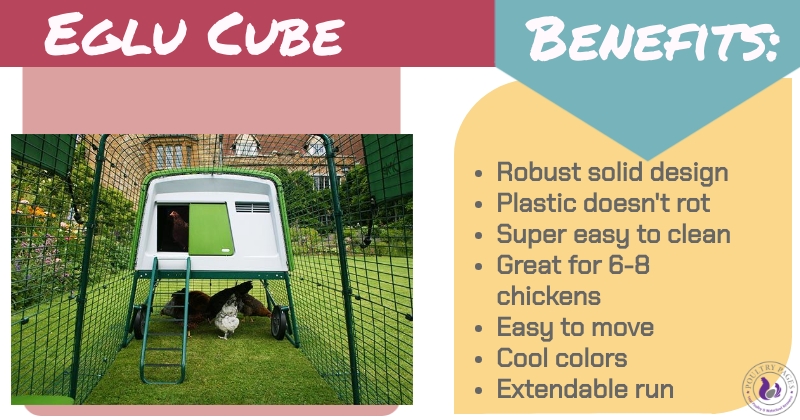
You can actually custom build the size of the run meaning you get exactly what you need/want – they really are ace. Perfectly well thought out designs with 30 day money back guarantee and a 2 year warranty.
Omlet aren’t sold on Amazon, so just google them or you can go direct to their website here: www.omlet.us
Most Versatile and Flexible Chicken Coop for 12 Chickens [Giantex]
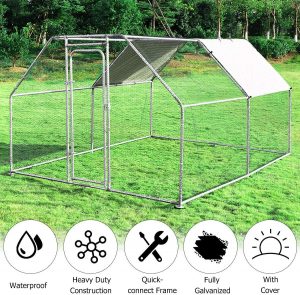
We have this solution on the farm housing our Cochins and it works really well. Giving them the safety and space to forage and roam.
- Comes in different sizes to suit your exact backyard needs.
- Cover with water and UV protected roof cover to offer shade and protection from snow and rain.
- Tough PVC coated wire hexagonal mesh
- Any coop can be placed inside or outside with the chicken door facing into the run (will require cutting a hole in chicken wire)
- Light weight and portable (just lift up and move to fresh grass if you want)
- Galvanized poles so they won’t rust
- Large walk in door with latch and steel ties for extra protection
- Easy to erect with quick connect frame poles.
- Pre-built holes to peg it down to the ground for extra protection
What would make it better: Easily add an electric fence around the perimeter like we have done in the pic.
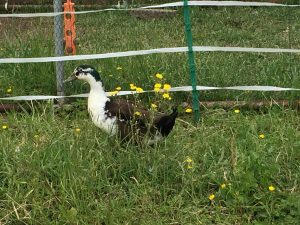
Best Budget Friendly Chicken Coop with Run for 12 Chickens [Coops and Feathers]
- Built on run
- Great access – 2 walk in doors, one into the coop and one into the run area.
- 2 windows for ventilation
- Large apex roof gives good air flow around the coop
- Roof across the whole coop and run area. Great for shade and protection from rain and snow!
- Roughly 9-10 inches roost space per bird, so adequate, depending on your breed of course…
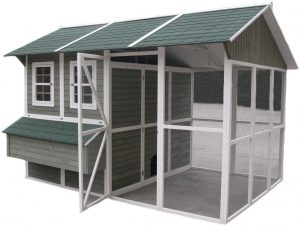
What’s could be improved: Wood thickness for extra sturdiness. It also has no screen protectors for those windows which arent facing into the run so are exposed. Not a huge deal as the coop and run are well ventilated anyway, so might not need them open.
DIY Top Tip: If you wanted screen protection over the windows when they are open, place up some chicken wire and cover with ladies tights to prevent flies.
So there you have it: The Best Chicken Coops for 12 Chickens & Why – I really hopes this helps saving you time trawling the internet & money.
Most Sturdy Designed Chicken Coop [OverEZ Large]
- AMAZING reviews online
- *30 mins DIY time to assemble
- 2 windows for ventilation
- Very sturdy build quality – floor and siding are treated with resin to help combat moisture
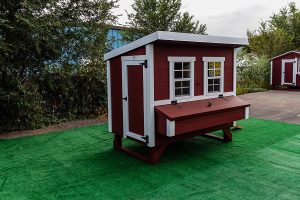 Has 4 great design, features that include:
Has 4 great design, features that include:
- Sloping roof to the rear, away from the nest boxes helping to keep the eggs drier.
- Doors all lock in the open and closed position
- Roosting bars at 2 different heights {as different breeds roost at different heights, most roost at 3-5ft}
- Add ons : A run, wheels to make it portable & an inside light!
What we didn’t like: Can’t put it together on your own, its comes flat pack, and the pieces can be heavy. *Takes slightly longer to build, on average taking people 1.5 hrs.
Our chicken coop is on its last legs! I made it as sturdy and as robust as humanly possible, firstly its on a metal frame with steel tractor tires, and that is all still in good condition. But wood has a finite lifespan, nothing lasts forever, even if you sand it, vanish and paint it each season – like we have!
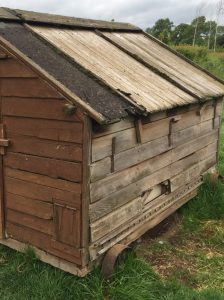
Time to look for a new one, which means hours, trawling the web and reading reviews. We have had literally dozens of coops on our farm over the years, im a proud 4th generation chicken owner, and in that time we have had some useless coops and some awesome ones. I’ve made a good few myself, added bits, extended them, added tires to turn them into tractors. I’ve had and done the lot, it been great fun.
So I know what works and I know what doesn’t. What doesn’t, breaks and usually very quickly costing you money. Its safe to say we have spent into the thousands, buying coops, and over the years so I’ve developed a strict criteria for buying coops. This criteria will help shortlist the best chicken coop for 12 chickens so you don’t waste any money. I’ll share it below.
Firstly, lets answer the size question
How big a chicken coop for 12 chickens?
Chickens will need 3 to 4 sqft of coop space per bird. Now that’s calculated by floor space which is fine so chickens can move around get to the waterer for a drink and don’t over heat with a flock size too large for the coop. But there’s 2 more points
- Roost space – each chicken (think Rhode Island Red or Welsummer size) will be need 8-12 inches width (wing to wing) roost/perch space. Id allow 10-14 inches for the length, so tail tip to beak. Larger breeds like Jersey giants or Orpington’s and Australorps will require more space.
- Nesting boxes, firstly make sure these are lower than the roosting bars. Chickens will naturally head for the highest roost space, if that’s the nesting boxes they will poop into them, spoiling them very quickly.
You will need 1 nesting box per 4-6 birds an your chickens will probably only use 1 or 2. Its odd, they pick a favorite box or two! It’s a complete myth that each chicken needs its own nesting box…..
What Makes a Good Chicken Coop:
Ventilation:
Absolutely critical even if you live in a cold climate. You need that air flow. Air flows both ways, people mainly only think of it as a one way street and it’s not.
Heat, pressure and moisture flow hot to cold or high to low.
When its hotter inside the coop, than outside, the heat direction of travel will be outward.
So too cool a coop its not cold air flowing in that allows this process, its actually allowing the outflow of hot air that will cool the coop.
Chickens can suffer from heat stroke very quickly and easily and this causes them to be put off laying or worse. This is why they also need to have access to fresh water. Having water in just the run isn’t enough. During the night if it’s hot they will need to hydrate.
What about moisture?
High levels of moisture can build up in chicken coop from the chicken poop. This poop contains ammonia, highly levels of ammonia causes respiratory issues amongst chickens.
Again ventilation is both in and out and is super important. I try and look for coops with vents at floor level as cold air and moisture fall, and vent(s) at the roof level as hot air and moisture rises. This will allow natural convention to occur which will keep the coop at optimal temperature, which is around 68F (20C).
Vent positioning
So most manufactures know that ventilation is critical and so most now have vents (always double check). Some, manufacturers though do something really silly……
If you place a vent in front of the roosting bars where the chickens sleep at night you place them directly in a draft. This will mean your chickens will catch cold, get sick and will again stop laying or worse.
If you live in a cold windy area pay particular attention to the direction you position the coop.
Best positioning for vents is in the middle of the coop or nearer the nesting boxes as at least they can be cooled during the day whilst they are hard at work laying your wonderful eggs!
Predator Proofing
If you’ve ever had a predator get into the coop you know the consequences can be so damaging. Its especially tough if you have kids. We had a fox get into the coop and it killed everything, only to take just one of our hens. It was such a sad time.
You need a coop that’s predator proof. Things like, if there are windows on the coop make sure they have screens covering them so nothing can sneak in. It will also help to keep the flies out.
Make sure the roof tiles or roof panels can’t be individually removed, I’m thinking raccoons here, they are crafty. But foxes and coyotes can also jump onto the roof and gain access.
Looks or latches on any doors, or the nesting boxes is a bonus, as most nesting boxes just lift up.
And if there’s not floor on the coop, i.e it just sits on the earth. Make sure nothing can dig under.
The siding, make sure nothing is sticking out so something can gain purchase to remove this panel. Having a sturdy design will mean nothing can bite or rip its way in either…
Sturdy Design
Yes as to help keep predators out having a well-built sturdy design is paramount. But you also need a coop that’s going to last!
Ever heard the saying ‘’you get what you pay for’’. The more you can spend on a coop the better the materials will be and the better the craftsman ship is, not always but like 99% of the time.
I’ve had roofs leak on me after a month and I’ve had a chicken pop door break after just a few weeks. Its just hassle you don’t want.
Treated Wood [or not to treat wood that is the question]
It’s an issue that most people have an opinion on, as most wood treatments contain chemicals. For me it’s simple, treated wood will last so much longer than non-treated and I need longevity from my coop. The choice is yours however…
Easy access
- A main walk-in door makes it so much easier than crawling in on your hands and knees. It also makes cleaning out the coop much more simple. Instead of doing hand stands trying to reach in from above to get into every nook and cranny.
- Access to the nest boxes from the outside makes life easier for collecting your yummy eggs each day!
- Can the chicken pop door, which is the door they use to come in and out of the coop, be opened and closed from the outside? If it can that’s bonus. Again if there is a run attached it just saves you have from having to go inside it to close and open the pop door each day.
Shade
Chickens will want some shade during a hot sunny day to cool off and relax. As I’ve already said its so easy for chickens to overheat. When chickens do overheat the consequences can sometimes be dire. Look for signs of lethargy or them not wanting to leave the coop.
 I actually have to feed mine (see pic) high water content fruits when its warm to keep them fed, as their appetite drops when its warm, and hydrated. Water melon is absolutely brilliant for this, its all natural too!
I actually have to feed mine (see pic) high water content fruits when its warm to keep them fed, as their appetite drops when its warm, and hydrated. Water melon is absolutely brilliant for this, its all natural too!
Anyway I was talking about shade – its vital to offer it to chickens and its where you should place down the waterer as chickens prefer cool water. No one is sure why, we think its a prehistoric throwback.
Add ons
Maybe these aren’t high on everyone’s list but I like coop that you could, if you wanted to, adapt a little. Things like
- Can you add wheels to make it portable and maybe turn it into a chicken tractor.
- Can you add a light inside easily?
- Could you string up a tarp under the roosting bars to catch the poop (make cleaning a doddle!)

